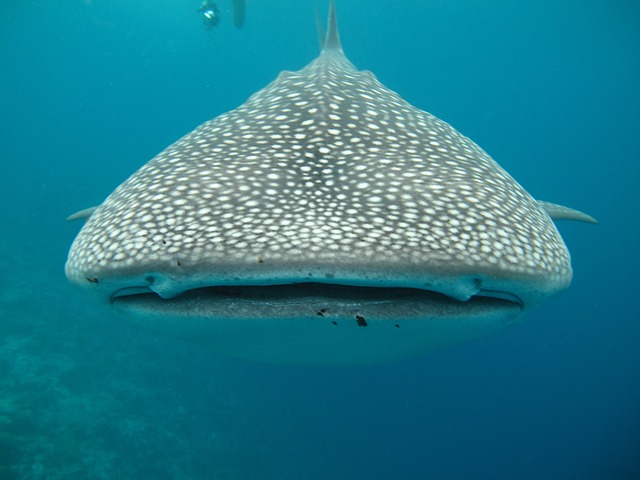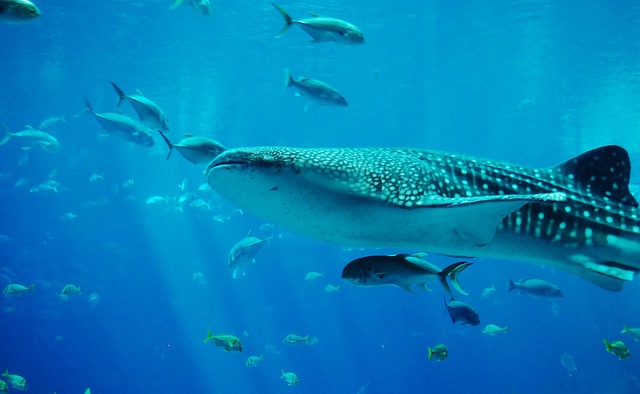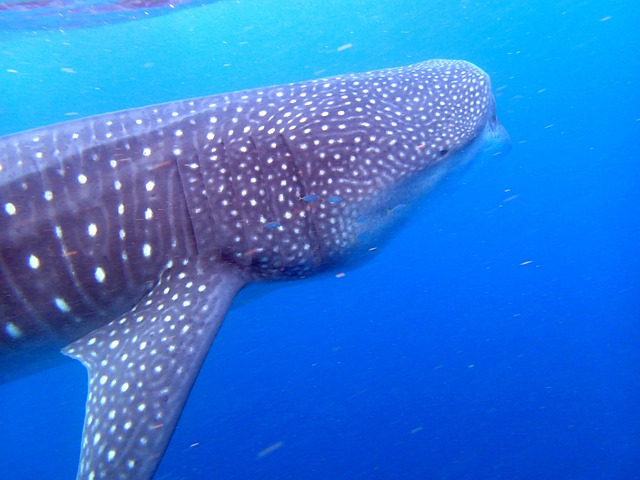Welcome to the underwater world of the magnificent whale shark! Considered the largest fish in the ocean, these gentle giants are a fascinating sight to behold. Imagine diving into the depths of the ocean and coming face to face with a creature that can reach up to 40 feet in length.
The thrill and wonder of encountering these majestic creatures is unlike any other. In this article, we will dive into the unique features and behaviors of whale sharks, exploring their size, physical characteristics, habitat, diet, social behavior, and conservation efforts.
Join us on this journey as we discover the wonders of the whale shark, one of the most fascinating creatures in the ocean.
Table of Contents
The Size and Physical Characteristics of Whale Sharks
Whale sharks are the largest fish in the ocean, and it’s no wonder why they have captivated the hearts and minds of divers and marine enthusiasts around the world. With some reaching up to 40 feet long, these gentle giants are a true marvel of nature. Their size alone is enough to leave anyone in awe, but their physical characteristics are equally as impressive.

One of the most striking features of the whale shark is its enormous mouth which can span up to five feet wide. This allows them to filter large quantities of water and food, making them one of the most efficient filter feeders in the ocean. Along with their massive mouths, whale sharks also have hundreds of tiny teeth that line the back of their throats to help trap and filter plankton and small fish.
In addition to their large mouths, the skin of whale sharks is also unique. Rather than scales, they have a thick layer of skin that is covered in a white and grey spotted pattern. These markings are as unique as fingerprints and can help researchers identify individual whale sharks. This spotted skin also serves as a form of camouflage, allowing them to blend in with their surroundings and avoid detection by predators.
Another physical characteristic that contributes to the success of whale sharks as a species is their powerful tails. These tails can propel them through the water at speeds of up to 3 miles per hour, making them excellent swimmers despite their size. Additionally, their tails also play a role in their communication with other whale sharks, as they use it to make booming noises that can be heard from a distance.
While their size and physical features are impressive, they also serve a greater purpose in the survival of whale sharks. As filter feeders, they play a crucial role in maintaining a healthy marine ecosystem. By consuming large quantities of plankton and small fish, they help keep their prey populations in check, preventing overgrowth that can disrupt the balance of the ocean’s food chain.
Whale sharks are found in all tropical and warm temperate seas, with hotspots in countries such as Australia, Mexico, and the Maldives. However, they are migratory animals, and their movement patterns are still not fully understood. It is believed that they follow food sources and favorable water temperatures, as well as migrate for mating purposes. This global distribution and migration patterns make it all the more important to protect their habitats and ensure their survival as a species.
In conclusion, the size and physical characteristics of whale sharks make them one of the most fascinating creatures in the ocean. Their impressive size and unique features contribute to their survival and success as a species, and their gentle nature makes them a pleasure to observe and interact with. As we continue to learn more about these magnificent creatures, it is crucial that we also take action to protect them and their habitats, ensuring their presence in our oceans for generations to come.

The Habitat and Migration Patterns of Whale Sharks
Whale sharks are known for their impressive size, with some individuals reaching up to 40 feet in length. They are also known for their unique physical characteristics, such as their large mouths, spotted skin, and powerful tails. But where can one find these majestic creatures in their natural habitat? In this section, we will dive into the world of whale sharks and explore their habitat and migration patterns.
Whale sharks can be found in all tropical and warm temperate seas around the world, making them a truly global species. However, there are specific hotspots where these gentle giants are most commonly seen. These include Australia, Mexico, and the Maldives, where whale sharks are a popular attraction for tourists and divers.
So, why do whale sharks migrate? These creatures have a highly nomadic lifestyle, with their movements influenced by factors such as food availability and mating. They are known to follow the seasonal blooms of plankton, their primary food source, which can vary in different parts of the world. Additionally, whale sharks also migrate to mate and give birth in specific areas, such as the Galapagos Islands and the Red Sea.
The migration patterns of whale sharks are not only important for their own survival, but also for the health of marine ecosystems. As filter feeders, whale sharks play a crucial role in maintaining a balance in the ocean’s food chain. They consume large amounts of plankton and small fish, keeping their populations in check and preventing them from overpopulating and disrupting the ecosystem.
Unfortunately, the habitats and migration routes of whale sharks are under threat from various human activities. One of the main threats is bycatch, which occurs when these creatures get caught in fishing nets and gear meant for other species. Habitat destruction, pollution, and human interaction, such as boat strikes and disturbance during feeding or mating, are also major concerns.
To protect these gentle giants and their habitats, conservation efforts are crucial. Many organizations and governments are working towards implementing measures to reduce bycatch and regulate human activities in areas where whale sharks are commonly found. For example, in the Philippines, fishing is banned in known whale shark feeding areas, and ecotourism activities are closely monitored to avoid harm to these creatures.
As responsible citizens, it is our duty to support and participate in these conservation efforts. When visiting areas where whale sharks are present, it is important to follow responsible tourism practices. This includes not touching or chasing the sharks, maintaining a safe distance, and respecting their natural behavior. By doing so, we can ensure the continued survival and success of these magnificent creatures.
In conclusion, the habitat and migration patterns of whale sharks are fascinating and essential to their survival. From their nomadic lifestyle to their role in maintaining a healthy marine ecosystem, these creatures are truly remarkable. However, it is our responsibility to protect them and their habitats so that future generations can continue to marvel at the wonders of the whale shark.
The Diet and Feeding Behavior of Whale Sharks
Whale sharks are known as the gentle giants of the ocean, and their diet and feeding behavior further solidify their peaceful nature. These magnificent creatures mainly feed on plankton and small fish, using their unique filtering technique to consume large amounts of food.
Whale sharks are filter feeders, meaning they use their large mouths to filter out their prey from the water. Their mouths can stretch up to four feet wide, allowing them to capture a large volume of water and food. This makes them one of the largest filter feeding animals in the world. The whale shark’s mouth also contains over 300 rows of tiny teeth, which are used to filter out the water and retain the food. This adaptation allows whale sharks to consume up to 1,500 pounds of food per day, making them one of the most efficient feeders in the ocean.
Their diet primarily consists of plankton, which includes small organisms such as krill, copepods, and fish larvae. Plankton is a vital source of food for many marine animals, and whale sharks play a crucial role in maintaining a healthy balance in the marine ecosystem. By consuming large amounts of plankton, they help regulate the population of these tiny organisms, preventing them from overpopulating and disrupting the ocean’s delicate food chain.
In addition to plankton, whale sharks also feed on small fish, squid, and crustaceans. They have been observed feeding on schools of anchovies, sardines, and mackerel, using their powerful tails to stun and capture their prey. This behavior is known as lunge feeding, where the whale shark propels itself towards its prey with its mouth open, creating a suction force that pulls in the food. This feeding technique is not only efficient but also fascinating to witness for divers and researchers.
Whale sharks follow a seasonal feeding pattern, where they migrate to areas with high concentrations of plankton. These locations can vary depending on the time of year and water temperature. Some popular feeding hotspots include the coast of Mexico, the Maldives, and the Ningaloo Reef in Australia. These locations provide the perfect environment for plankton to thrive, making it an ideal feeding ground for whale sharks.
Despite their size and feeding habits, whale sharks are not aggressive towards humans. In fact, they are known to be docile and curious creatures, often approaching boats and divers without any signs of fear or aggression. This makes it possible for divers to have up-close and personal encounters with these gentle giants, making for an unforgettable experience.
In conclusion, the diet and feeding behavior of whale sharks play a significant role in maintaining a healthy marine ecosystem. As filter feeders, they provide an essential service to the ocean by regulating the population of plankton and small fish. Their unique feeding techniques and migration patterns make them a fascinating species to observe and study. However, it is essential to ensure responsible tourism practices when interacting with whale sharks to protect their habitats and safety.
The Social Behavior of Whale Sharks
Whale sharks, despite their immense size and intimidating appearance, are actually very social creatures. They are mostly solitary animals, but can occasionally be seen in groups during feeding or mating. In this section, we will explore the social behavior of these gentle giants and the role it plays in their survival.
Whale sharks are known to be non-aggressive and docile towards humans, making them a popular attraction for divers and tourists. But what about their interactions with their own kind? Researchers have observed that whale sharks have a complex social structure, with some level of hierarchy within their groups. This hierarchy is determined by size, with larger individuals having a dominant role in the group.
During feeding, whale sharks can be seen swimming in a circular pattern, with the larger individuals in the center and the smaller ones on the outer edge. This allows for efficient filter feeding, as the smaller sharks can take advantage of the food that the larger ones miss. This cooperative behavior shows that whale sharks not only tolerate each other’s presence, but also work together for a common goal.
While most of their interactions are peaceful, researchers have also observed aggressive behavior among male whale sharks during mating season. This is usually seen in the form of ramming and biting, as males compete for the attention of a female. However, this behavior is short-lived and does not lead to any serious injuries.
The social behavior of whale sharks is also important in their reproduction. These creatures are ovoviviparous, meaning they give birth to live young. Females can carry up to 300 pups at a time, but only a few will survive to adulthood. This is where their social behavior comes into play. Whale sharks have been observed forming nursery groups, where young sharks can learn from their more experienced counterparts. This increases their chances of survival and ensures the continuation of their species.
It is important to note that human interference and irresponsible tourism practices can disrupt the social behavior of whale sharks. These animals are highly sensitive to noise and disturbance, which can cause them to alter their behavior and even leave their feeding or mating grounds. This is why it is crucial for tourists and divers to follow responsible guidelines when interacting with whale sharks.
Conservation efforts are also vital in protecting the social behavior of whale sharks. By preserving their natural habitats and reducing human interaction, we can ensure that these creatures can continue to exhibit their natural social behaviors without any disruption. This will also contribute to maintaining a healthy marine ecosystem, as the presence of whale sharks benefits other species through their filter feeding behavior.
In conclusion, the social behavior of whale sharks is a fascinating aspect of their lives. Despite being solitary creatures, they exhibit a level of cooperation and hierarchy within their groups. Their social interactions not only contribute to their survival but also play a crucial role in the conservation of their species. By understanding and respecting their behavior, we can ensure that these magnificent creatures continue to thrive in our oceans for generations to come.

Threats and Conservation Efforts to Whale Sharks
Whales sharks, despite their impressive size and powerful presence, are unfortunately facing a number of threats that are putting their survival at risk. These gentle giants, which have roamed the oceans for millions of years, are now facing human-induced dangers that are rapidly depleting their numbers. It is imperative that we understand and address these threats in order to protect and preserve these magnificent creatures for future generations to appreciate. In this section, we will discuss the main threats to whale sharks and the ongoing conservation efforts to ensure their survival.
Threats to Whale Sharks One of the main threats to whale sharks is bycatch, which occurs when these animals are accidentally caught in fishing nets or gear. This is a common occurrence in many parts of the world, especially in areas where whale shark hotspots coincide with fishing grounds. The accidental capture of whale sharks in fishing gear can result in serious injuries or even death for these animals, as they are unable to free themselves and often suffocate. Moreover, this threat is particularly harmful as whale sharks have a slow reproductive rate, making it difficult for their populations to recover from such losses. Habitat destruction is another major threat to whale sharks. As these animals rely on specific habitats for food and breeding, any damage to these areas can have a significant impact on their survival. Coastal development and pollution, such as oil spills and plastic debris, can disrupt the delicate balance of marine ecosystems and harm these animals. In addition, climate change is altering ocean temperatures and currents, which can affect the abundance of plankton and fish, the main sources of food for whale sharks.
Conservation Efforts Thankfully, there are ongoing conservation efforts to protect whale sharks and their habitats. One of the most effective ways to address the threats to these animals is through the implementation of fishing regulations and management practices. This includes the use of fishing gear modifications, such as escape panels in nets, to prevent bycatch. Additionally, marine protected areas have been established in certain hotspots to limit fishing activities and protect the habitats of these animals. Conservation organizations, such as the Whale Shark Conservation Society and the Marine Megafauna Foundation, are also working towards promoting awareness and education about the importance of whale sharks and their conservation. They conduct research and monitoring programs to gather data on the behavior and movement patterns of these animals, which can inform conservation strategies and policies. Furthermore, these organizations work with local communities to develop sustainable and responsible practices for tourism activities, which can greatly benefit the local economy while minimizing the negative impacts on whale sharks.
How You Can Help As individuals, we can also contribute to the conservation efforts for whale sharks. It is important to remember that every action we take, no matter how small, can make a difference in protecting these animals. One of the best ways to support whale shark conservation is by choosing responsible and ethical tourism activities when interacting with these creatures. This includes avoiding activities such as feeding or touching them, and making sure to follow guidelines and regulations set by conservation organizations. Additionally, we can all play a part in reducing our carbon footprint and minimizing our impact on the environment. By reducing the use of single-use plastics, recycling, and supporting sustainable fishing practices, we can help create a healthier ocean for whale sharks and other marine life to thrive in.
Conclusion In conclusion, the threats facing whale sharks are numerous and complex, but with the help of ongoing conservation efforts and responsible actions from individuals, there is hope for their survival. It is our responsibility to protect and preserve these incredible creatures for future generations to witness and admire. Let us all work together to ensure that these gentle giants continue to roam the oceans for many years to come.
